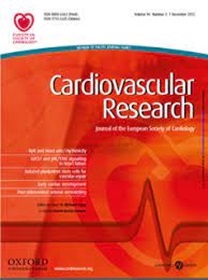血小板和炎症——Bruneck研究和PACMAN-AMI试验中血小板非编码RNA含量和释放的见解
IF 13.3
1区 医学
Q1 CARDIAC & CARDIOVASCULAR SYSTEMS
引用次数: 0
摘要
目的血小板含有非编码rna (ncRNAs),其测量可作为血小板聚集学的补充。方法和结果在以社区为基础的Bruneck研究(n = 338)中,我们生成了富血小板血浆(PRP)、贫血小板血浆(PPP)和血小板。使用各种激动剂对PRP进行聚集,然后处理成血小板释放物。通过实时聚合酶链反应来测量ncrna的释放、PPP和血小板。血小板ncRNA释放表现为激动剂特异性、剂量依赖性和阿司匹林抑制。胶原蛋白触发了大多数ncrna的最强释放,而miR-150对ADP有高反应,miR-21对花生四烯酸有高反应。比较ncRNA释放到聚集的动态范围,在高激动剂浓度下,聚集达到最大值,而ncRNA继续上升。全队列关联显示,炎症参数如中性粒细胞计数和c反应蛋白与血小板聚集和ncRNA释放呈负相关。同样,在分离的血小板中,高的白细胞来源的RNA含量与聚集呈负相关。在阿司匹林使用者中不存在负相关。通过对血浆无血小板释放物和血小板的实验,包括大小排斥层析、超离心和降解实验,我们发现microrna和yrna由蛋白质携带并易于释放,而环状rna、长链非编码rna和信使rna由囊泡携带并优先保留。最后,我们评估了265例PACMAN-AMI试验急性心肌梗死(AMI)患者血浆中ncRNA对短期和长期双重抗血小板治疗(DAPT)的反应。大部分的DAPT效果在4周时已经达到,在52周时进一步降低,揭示了短期和长期的DAPT效果没有被聚合所捕获。结论:离体血小板中的炎症和白细胞来源的rna与体外血小板反应降低有关,可能反映了体内预激活的衰竭。我们发现,蛋白质结合的ncrna很容易从血小板中释放出来,而囊泡结合的ncrna则优先保留。我们强调了ncrna作为生物标志物补充聚集性的潜力。本文章由计算机程序翻译,如有差异,请以英文原文为准。
Platelets and inflammation - insights from platelet non-coding RNA content and release in the Bruneck Study and the PACMAN-AMI trial
Aims Platelets contain non-coding RNAs (ncRNAs), and their measurement may complement platelet aggregometry. Methods and results In the community-based Bruneck Study (n = 338), we generated platelet-rich plasma (PRP), platelet-poor plasma (PPP) and platelets. PRP was subjected to aggregometry using various agonists and processed to platelet releasates thereafter. Releasates, PPP and platelets underwent real-time polymerase chain reactions to measure ncRNAs. Platelet ncRNA release appeared agonist-specific, dose-dependent, and inhibited by aspirin. Collagen triggered the strongest release for most ncRNAs, whereas miR-150 was hyperresponsive to ADP, and miR-21 was hyperresponsive to arachidonic acid. Comparing the dynamic range of ncRNA release to aggregation, aggregation reached a maximum at high agonist concentrations, while ncRNAs continued to rise. Cohort-wide associations showed that inflammation parameters like neutrophil counts and C-reactive protein correlated inversely with platelet aggregation and ncRNA release. Similarly, a high leukocyte-derived RNA content in isolated platelets correlated inversely with aggregation. Inverse correlations were absent in aspirin users. Through experiments on plasma-free platelet releasates and platelets, including size-exclusion chromatography, ultracentrifugation and degradation assays, we discovered that microRNAs and YRNAs are carried by proteins and readily released, while circular-, long non-coding- and messenger RNAs are carried by vesicles and preferentially retained. Finally, we assessed ncRNA responses to short- and long-term dual antiplatelet therapy (DAPT) in plasma from 265 patients with acute myocardial infarction (AMI) of the PACMAN-AMI trial. Most of the DAPT effect was already achieved by 4 weeks, with a further reduction at 52 weeks, revealing a short- and long-term DAPT effect not captured by aggregometry. Conclusions Inflammation and leukocyte-derived RNAs in isolated platelets are associated with reduced platelet responses ex vivo, potentially reflecting exhaustion through pre-activation in vivo. We show that protein-bound ncRNAs are readily released from platelets, whereas vesicle-bound ncRNAs are preferentially retained. We highlight the potential of ncRNAs as biomarkers complementing aggregometry.
求助全文
通过发布文献求助,成功后即可免费获取论文全文。
去求助
来源期刊

Cardiovascular Research
医学-心血管系统
CiteScore
21.50
自引率
3.70%
发文量
547
审稿时长
1 months
期刊介绍:
Cardiovascular Research
Journal Overview:
International journal of the European Society of Cardiology
Focuses on basic and translational research in cardiology and cardiovascular biology
Aims to enhance insight into cardiovascular disease mechanisms and innovation prospects
Submission Criteria:
Welcomes papers covering molecular, sub-cellular, cellular, organ, and organism levels
Accepts clinical proof-of-concept and translational studies
Manuscripts expected to provide significant contribution to cardiovascular biology and diseases
 求助内容:
求助内容: 应助结果提醒方式:
应助结果提醒方式:


